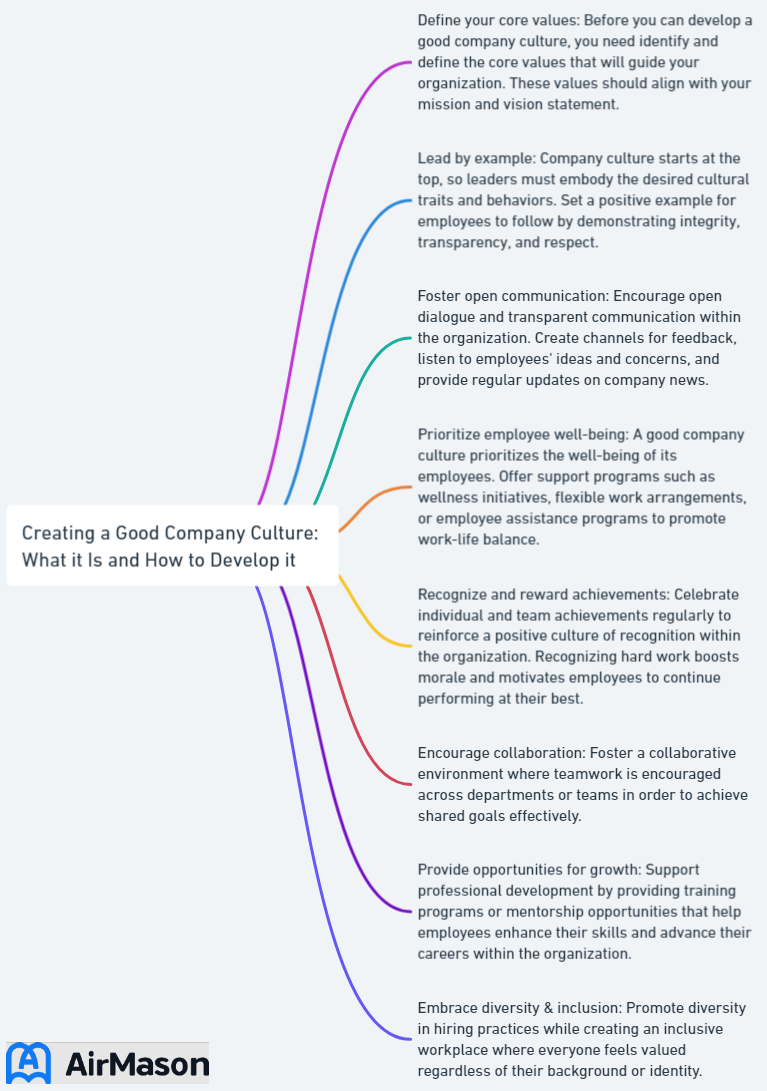
Did you know that investing in a good company culture can significantly boost your business success, employee satisfaction, and retention? It’s true! In today’s competitive market, companies need to prioritize building a positive and thriving work environment to stay ahead of the curve. So, let’s dive into the world of company culture and discover what makes it so essential and how to develop it in your organization.
In this comprehensive guide, we’ll explore the importance of company culture, its key components, strategies for development, measuring its impact, and overcoming challenges. By the end, you’ll have a solid understanding of the significance of organizational culture and how to foster a great one within your own company.
Key Takeaways
- Create a strong company culture with shared values and vision, supportive leadership, and open communication.
- Assess your current culture to align it with business goals & implement motivating initiatives for maximum success.
- Take inspiration from companies like Google & Microsoft to create a positive workplace environment that encourages engagement & productivity.
Understanding the Importance of Company Culture
A thriving business is often underpinned by a robust organizational culture, which significantly influences employee satisfaction, retention, and productivity. But what exactly makes a great company culture? It’s a combination of:
- Shared values
- Vision
- Supportive leadership
- Open communication
These elements create a positive atmosphere for employees to work in, making the workspace look like an inviting and motivating environment, while also promoting work life balance.
A healthy culture, specifically a healthy organizational culture, yields numerous benefits such as a strong organizational culture:
- Reduced employee turnover
- Decreased absenteeism
- Enhanced job satisfaction
- Improved employee engagement
- Bolstered productivity
By fostering a positive place to work that employees want, they can reach their full potential every day, ultimately leading to business success.

An Organization’s Culture
An organization’s culture encapsulates its collective values, beliefs, and behaviors that shape the way individuals interact within the workplace. It is the invisible force that guides decision-making, influences employee morale, and ultimately determines the organization’s trajectory. This culture manifests in various forms, from the way projects are approached to the level of autonomy granted to employees. A healthy organizational culture fosters an environment of trust, collaboration, and innovation, enabling individuals to work cohesively towards shared goals. Conversely, a toxic culture can hinder productivity, stifle creativity, and lead to high turnover rates. Recognizing the significance of an organization’s culture is paramount in cultivating a thriving and sustainable work environment.
Key Components of a Good Company Culture

Three fundamental elements contribute to the creation of a successful company culture: shared values and vision, supportive leadership, along with open communication and collaboration. In this context, culture is one of the most important aspects of shaping the overall workplace culture and fostering a positive environment where team members can thrive.
Shared Values and Vision
Shared values and vision are the foundation of any great company culture. They create a strong sense of unity and purpose, helping to engage and empower team members. When employees feel aligned with the company’s core values and mission, they are more likely to be motivated and driven to contribute to the organization’s success.
Cultivating shared values necessitates:
- An assessment of your company’s current culture
- Pinpointing areas that need improvement
- Devising a culture strategy in line with your organizational objectives
It is important to remember that your core values are the foundation of who your company is. They define what you do and why you do it, reflecting your company’s values.
Supportive Leadership
Healthy company culture relies heavily on effective leadership. Leaders who promote employee growth, trust, and engagement contribute significantly to the overall success of the organization. Companies can cultivate a cadre of future leaders who embody the desired company culture by proactively identifying and nurturing leadership potential.
According to Coleen Seward Ryan, there are two great ways of being an accessible leader: active leadership accessibility and passive leadership accessibility. By ensuring employees feel supported and valued every day, leaders can boost engagement and foster a positive work environment where team members can excel professionally.
Open Communication and Collaboration
Open communication and collaboration are essential components of a thriving company culture. They foster teamwork, spark innovation, and enable problem-solving, resulting in increased productivity and enhanced employee satisfaction. A culture that promotes open dialogue and encourages collaboration creates an environment where employees feel connected and engaged every day.
Two-way and transparent communication is a cornerstone of building a great company culture. Regular dialogue between managers and employees is essential for achieving this. By ensuring employees feel heard and valued, organizations can create a positive work environment that nurtures creativity, collaboration, and excellence, allowing team members to reach their highest potential.
Fostering Positive Culture in the Workplace
Creating a positive culture in the workplace is paramount for nurturing a thriving and motivated team. A positive culture in the workplace encompasses the values, beliefs, and attitudes that shape the work environment. It begins with open communication and a shared sense of purpose among employees. This culture encourages collaboration, empowers individuals, and fosters a sense of belonging. When positive culture in the workplace is prioritized, it not only enhances productivity but also promotes employee well-being and satisfaction, ultimately leading to a more successful and harmonious work environment.
Strategies for Developing a Strong Company Culture
Having explored the key components of a good company culture, it’s time to examine strategies that foster a robust organizational culture. These strategies involve assessing your current culture, aligning it with business goals, and implementing culture-building initiatives.
Assessing Your Current Culture
The initial step in fostering a robust company culture involves an assessment of the current culture and identification of areas for improvement. Gaining an understanding of the culture of your company is essential for deciding where to take it next. It also helps you create and shape the desired culture within your own business..
Several methods can help you assess your corporate culture, such as:
- Determining your preferences
- Researching the company
- Evaluating its online presence
- Observing the work environment
- Asking questions
- Conducting employee surveys
This evaluation not only helps you identify areas for improvement but also ensures that your company culture aligns with your employees’ desires.
Aligning Culture with Business Goals
A crucial step towards cultivating a robust company culture is ensuring your culture aligns with your business goals. It ensures that the company’s values and vision are reflected in its daily operations and decision-making processes. By connecting culture to strategy, you can create a unified and purposeful organization that positively impacts both employees and the company’s success.
To successfully align your culture with your business goals, it’s important to avoid common mistakes, such as:
- Failing to link culture to strategy
- Moving too fast without proper planning
- Not aligning leadership with the desired culture
- Lack of clarity in communicating goals and purpose
- Undefined or absent company values
- Making bad hiring decisions
- Poor communication throughout the alignment process.
Implementing Culture-Building Initiatives
After assessing your current culture and aligning it with your business goals, the next step is to execute culture-building initiatives to fortify your company culture. Initiatives like employee recognition programs and professional development opportunities can significantly impact employee engagement and satisfaction.
Cultivating a robust company culture and boosting employee engagement can lead to a more productive and contented workforce on a daily basis. Employee recognition is a key factor in building strong, positive cultures that are seen in the best workplaces.
Measuring the Impact of Company Culture

Measuring the impact of company culture is necessary to gauge the effectiveness of culture-building efforts. This can be done by assessing:
- Employee satisfaction
- Retention rates
- Productivity
- Overall business performance
By gauging the success of your company culture, you can ensure that it is positively impacting your employees every day.
Keep in mind, the creation and maintenance of a thriving company culture is a continuous process. Continuously monitoring and evaluating the impact of your culture-building initiatives will help you adapt and make improvements as needed, ensuring a successful and thriving organization where employees feel engaged and supported every day.
Examples of Companies with Exceptional Company Cultures

Organizations like Google and Microsoft serve as prime examples of companies with exceptional cultures. By investing in a positive company culture and prioritizing employee well-being, these companies have reaped the benefits of increased employee engagement, boosted morale, and enhanced productivity.
These examples showcase the potential advantages of exceptional company cultures and demonstrate the importance of investing in a nurturing and supportive environment for employees. By following their lead and avoiding a toxic company culture, you too can create your own company culture where employees thrive and contribute to your organization’s success.
Collaborate Effectively
To collaborate effectively is essential for any team striving to achieve its goals. It involves a harmonious blend of communication, shared objectives, and mutual respect among team members. Open and transparent communication is the cornerstone of successful collaboration. Each member should be encouraged to express their ideas and concerns, ensuring that everyone’s voice is heard and valued. Additionally, setting clear and achievable objectives provides a roadmap for the team, aligning efforts towards a common purpose. Moreover, it’s crucial to acknowledge and appreciate the diverse strengths and skills that each team member brings to the table. This recognition fosters a sense of belonging and encourages individuals to contribute their best. In essence, when a team collaborates effectively, they become greater than the sum of their parts, achieving results that would be impossible to attain individually.
Addressing and Overcoming Challenges in Building Company Culture

The path to building a robust company culture isn’t devoid of challenges. However, by implementing culture-building initiatives such as open communication, shared values, and supportive leadership, you can address these challenges and create an organization that fosters growth and success.
In the face of growth and evolution, your company needs continuous evaluation, feedback, and adaptation to maintain a thriving organization where employees feel engaged and supported. By staying proactive and adaptive, you can overcome challenges in building company culture and create a thriving workplace that benefits both your employees and your business.
Summary
In conclusion, company culture plays a vital role in the success of your organization, employee satisfaction, and retention. By understanding the importance of company culture and implementing strategies to develop a strong, positive work environment, you can create a thriving organization where employees can reach their full potential.
Remember, the key components of a good company culture include shared values and vision, supportive leadership, and open communication and collaboration. By continuously evaluating and adapting your culture-building efforts, you can overcome challenges and create a company culture that fosters growth, success, and employee well-being.
Frequently Asked Questions
What are signs of good company culture?
Having lots of well-qualified job applicants, creating an atmosphere of excellence, promoting clear company values, low employee turnover and constructive conflict resolution, minimal office politics, high-quality employee referrals and a high level of trust are all signs of a great company culture.
What are the 3 C’s of company culture?
The 3 C’s of company culture are Communication, Connection and Caring – focusing on these values encourages employees to feel connected, empowered and motivated, resulting in loyalty and productivity. Consistency and Communication are also important components of successful company culture.
What is an example of strong company culture?
Paragraph 1: Publix Super Markets, Southwest Airlines and Adobe all exemplify strong company culture by putting their core values and purpose-driven priorities first. Their focus on altruism and financial performance demonstrates that it is possible to maintain a healthy company culture while also achieving success.
What are the key components of a good company culture?
Splitting the text into paragraphs: Paragraph 1: A good company culture is built on shared values and vision, strong leadership, and open communication and collaboration. These are the key ingredients for success. Paragraph 2: None (as there are no double newlines in the provided text)
How can I assess my company’s current culture?
Assess your company’s current culture by researching, evaluating online presence, observing the work environment, asking questions, and conducting employee surveys to gain a better understanding of your current culture. Taking these steps will help you identify areas of strength and opportunity.